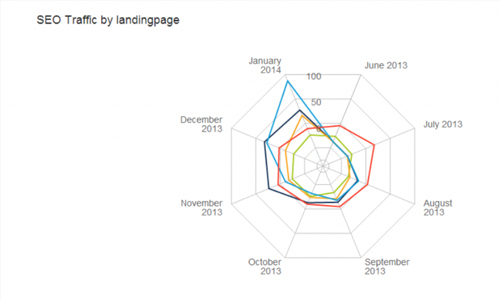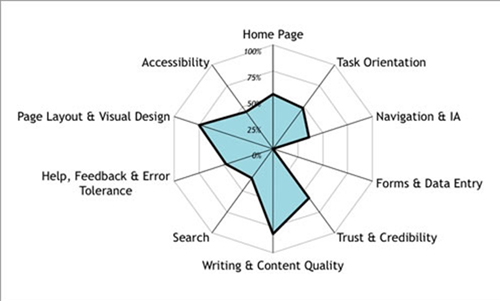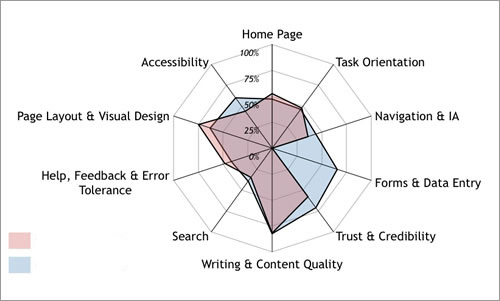Innovations in real estate marketing can help drive a company’s ability to hit their desired Key Performance Indicators. Through Bluetext’s experience working with top real estate brands like JLL and Kettler we understand what drives integrated marketing and digital marketing results.
SPEED
Faster websites make more money for their companies. Fast includes how long it takes your real estate website to load, but also how long it takes the real estate website search engine to show the user the type of available product that matches their search. Some sites use real time API calls and tons of third-party data services that bog down a search performance. This performance hit hurts seo, conversion, and engagement metrics. The bottom line is performance matters. The relationship between performance and revenue has been shown over and over again. Here are just a few examples:
- Amazon loses 1% of sales for every 100ms it takes their site to load.
- Shopzilla reduced their loading time from 7 seconds to 2. This performance boost resulted in a 25% increase in pageviews and a 9.5% increase in revenue.
- Mozilla shaved 2.2 seconds off their landing pages and increased download conversions by 15.4%, generating millions of additional Firefox downloads every year.
Ways to speed up your website include:
- Enable CMS compression
- Optimize your images
- Move JavaScript files to the footer
- Merge CSS files – Inline small CSS files
- Use a Content Delivery Network
- Minimize the number of HTTP requests
- Fix your 404 errors
- Take care of your page size
- Reduce the number of API calls
LOCATION AWARE USER EXPERIENCES
The other innovation real estate marketing executive need to consider is launching location aware marketing platforms and tools. Along with the adoption of HTML5, the Geo-location API has become very powerful technology. This allows your site to receive geographic positioning information using JavaScript. Once you have a location aware site or app, you are able to provide more accurate and appropriate content for your visitors. This is called geo-marketing. Geo-marketing is a relatively new concept defined as:
- The integration of geographical intelligence into various aspects of marketing, including websites and sales and distribution.
Although a new term, the principle of geo marketing has been around for a while. Facebook has been utilizing this approach for some time. Facebook gathers location-based data (based on users’ IP addresses) then show advertisers appropriate content for that geographic region. Google and other search engines also use this functionality and include location based search results for their users.
Your real estate website should offer the ability to search where you are located to offer up products around you. Of course many people search for information in another region for relocation scenarios, but the majority are in market moves and these use cases need to be addressed with a fast geo-personalized user experience.
We’d love to talk to you about your real estate marketing need. Let’s chat:
This goes to the heart of every company’s SEO strategy. The clues come in a patent filing for something called an “implied link.” Before I explain why this is important, let’s first take a trip back to the early days of SEO and link-building.
Early on, Google would evaluate where a site ranks for any given search by looking at how many other sites were linking back to that page. If you were a valuable site, visitors would link to you in order to share that with their audience or to cite you as a good resource. That type of analysis would seem like an obvious way to measure the quality of the site.
But SEO gurus are always trying to stay one step ahead, and once link-farms and other shady techniques for creating myriads of back-links became prevalent, Google recognized that there’s no way to verify whether a link was added because a user genuinely likes the content or whether the link was paid for. The quality of a link can be corrupted through a wide variety of Black Hat tricks, and thus the value of all links came into question.
And while Google has updated its algorithms on numerous occasions over the years, that doesn’t mean that links aren’t still valuable for SEO. They are just much less valuable than they once were. Google is now much more selective about the quality of the site that is doing the linking. The New York Times continues to be the gold standard for the most valuable links.
But what if a publication like the Times mentions a brand or its product without a hyperlink? Shouldn’t that carry some weight, even though it doesn’t include a url?
That’s where Google’s patent comes into play. SEO insiders believe that the patent is related to last year’s Panda update, and that it describes a method for analyzing the value of “implied links,” that is, mentions on prominent sites without a link.
Let’s say the Times mentions in an article the website of NewCo as a great resource for a particular topic, but doesn’t include a link to NewCo’s website. Previously, there really wasn’t a measurable way for NewCo to benefit from that quality mention. With implied links, Google sees the mention in the Times article and factors that into its search ranking.
Implied links are also used as a sort of quality control tool for back-links in order to identify those that are most likely the result of Black Hat tricks. For example, if Google sees numerous incoming links from sites of questionable quality, it might search for implied links and find that no one is talking about that brand across the internet. Google looks at that evidence from the implied links to determine if the back-links are real and adjusts the rankings accordingly.
Here are four tips for adapting to Google’s focus on implied links:
• Don’t abandon your link-building strategy. Earned links are still effective when they come from valued sites. The most valuable links will still be for relevant, unique content.
• Brand reputation is key. When asking for mentions on other sites, try to have them use your brand name as much as possible. The same is true when you are posting on other sites. Use your brand name. Do the same in descriptive fields such as bios at the bottom of contributed content.
• Engage your audiences in conversation. Similar to word-of-mouth marketing, the more your brand name is being mentioned, even without links, the more it will benefit your SEO. Encourage that conversation as much as you can.
• Be creative and flexible. Google is always evolving its search engine algorithms. It’s difficult, but not impossible, to predict how they may change over the next year, or how effective today’s best practices will be tomorrow if you know how to follow the clues.
Spider Chart, Spider Chart,
Visualizes whatever a spider can
Spins a chart, any size,
Catches insights just like flies
Look Out!
Here comes the Spider Chart
A spider chart plots the values of each category along a separate axis that starts in the center of the chart and ends on the outer ring. These charts are great ways of visualizing the strengths and weaknesses of your current or future state website user experience. At Bluetext we have a deep focus on the science of user experience. After all, when you design and build sites for Fortune 500 companies, every fraction of a percent counts.
Bluetext likes to help visualize the various states of our analysis in spider graphs.
Competitive Analysis Visualization Through Spider Graphs
In today’s fast moving digital marketing world it’s critical to be a watchful eye for our clients to ensure they have a competitive advantage. A real time pulse and visualization of where they fall in the competitive marketplace can be very valuable. The below sample spidergraph can show a marketing leader where they stack in many categories. They can review these sequentially chronologically to see how they are progressing and ensure they have the best opportunity to capture and convert users across their desired journeys to achieve the key performance indicators the site is measured against.
SEO and Landing Page Optimization Visualization Through Spider Graphs
If you really want to impress during a presentation, this is the chart for you. It allows you to display multivariate data easily while also impressing with the visual appeal of its radar shape. Check out the chart above which shows SEO traffic by landing page. This Spider Chart stylishly displays SEO traffic for each series of pages in a specific time frame. This kind chart allows you to easily see real SEO traffic rather than just keyword ranking reports like those from Google Analytics. At the end of the day, the quality and amount of traffic matters more than just keyword ranking. translations The Spider Chart can be used to hold the attention of your audience as you explain the insights you’ve discovered in a way which won’t scare them off.

These charts are just the tip of the data visualization iceberg. Talk to us at Bluetext about your story, brand, or data visualization needs.
Brand Strategy. Brand Presentation. Brand Delivery. Bluetext.
If anyone is looking for a strong example of the impact of website personalization, they don’t need to look any further than this year’s redesign of ESPN.com. ESPN’s move shouldn’t come as a surprise—after all, most enterprises redesign their websites every 18-to-24 months. But the reason that ESPN received so much attention is that it made one very significant strategic shift—its new website adapts to the person who is viewing it.
Some of the techniques that were built into the site allow it to reflect the location, preferences, interests and the device of each of its visitors. For example, it can predict (within reason-more on that later) your favorite team based on its best guess on your location. Once preferences are determined, it can prioritize relevant content every time you return to the site. That means the dynamic delivery of relevant content, a tailor-made river of information that is constantly updated.
ESPN certainly isn’t a pioneer in website personalization—after all, Amazon has been delivering that type of individualized content for years. But ESPN has figured out what every enterprise company needs to learn: Website visitors across all industries and sectors now expect at least some level of a customized experience. In fact, according to one recent survey, three-quarters of online consumers get frustrated when websites offer content that has nothing to do with their interests.
In other words, enterprise organizations that don’t start offering a more personalized experience will soon see their target audience abandoning their websites—resulting in lost opportunities for conversion, and, ultimately, lost revenues.
Here are four tips to help get you on your way to a better customized experience for your visitors:
Go Mobile First. This means installing technology that identifies the various devices that visitors use to view your content. First and foremost, Google rewards mobile-friendly sites in its page ranking, and is beginning to penalize those that aren’t. Viewers using their mobile devices need to be easily able to access content on those devices, and that requires a far different design than for a desktop or laptop.
Recognize the Buyer’s Journey. A first time visitor is going to need different types of content than someone who has already visited the site on several occasions. That means more general explanatory content for first-time visitors, with content moving towards specific questions and specifications as they move through the journey and towards a purchasing decision.
Use the Best Tools for Persona-based Content. Cookie technology is a necessity to understand and track where returning visitors have been on the site, what types of information they have sought, and what they might need next. Anticipating their needs and interests will result in a significant increase in conversion, and a decrease in frustration.
Allow Visitors to Contribute Their Own Personalization Settings. In the case of ESPN, it might seem obvious to assume that a visitor from Washington, D.C., was a Washington Nationals fan. translate But they could just as easily be a Baltimore Orioles lover. Checking in with that visitor directly will deliver better engagement, and better results.
Ok all you Thornton Mellon fanatics, the stats are in and the truth must be told. Some interesting data points I hope you all reflect on as you gear up for going back to school.
DATA POINT NUMBER ONE – DEDICATED TO OUR FAVORITE TEACHER SAM KINISON
The mobile revolution is complete. Smartphones account for more than half of searches in 10 countries—including the U.S. and Japan—according to Google, which didn’t release exact percentages or a full list of countries.
Why this is important?
Is every aspect of your digital infrastructure optimized for mobile?
You shouldn’t just stack your desktop elements. You should think through the human factors of mobile design and what your users truly want in the palm of their hand on first visit. Mobile first should be in the DNA of your marketing organization.
DATA POINT NUMBER TWO: THE TRIPLE LINDY OF DATA POINTS
60% of B2B marketers use web traffic to measure success instead of using sales lead quality or social media sharing.
Why this is important?
Success comes down to the key performance indicator and the analytics that you can generate. It’s much easier to track performance and measure return on investment with reliable website traffic data. Great data gives you a clear picture of an online campaign’s viability, but traffic isn’t your only solution. This stat also shows the immaturity of marketing measurement in the majority of organizations and the need for more in-depth data and analysis. If you can ramp up your content marketing analytics in 2015, you’ll be leaps ahead of your competitors.
DATA POINT NUMBER THREE: EMAIL GETS NO RESPECT
63% of consumers prefer to be contacted by email
A new study by Adobe claims that marketers are failing to engage ‘email addicts.’
While 63% say they prefer to be contacted by email, only 20% favor direct mail, 6% social media, 5% the brand’s mobile app, 4% text message and 2% phone.
Why this is important?
Surprisingly, this shows that email campaigns are favored way above even the second most-preferred form of contact from brands, suggesting that email marketing should still be high on every digital marketer’s agenda.
Last week some very interesting data came out of Parse.ly, an analytics firm which collects data for 400 digital publishers including Conde Nast, Reuters, Mashable, and The Atlantic. The headline is that, as of June 2015, Facebook is driving more traffic to websites than Google’s sites including google.com and Google News.
HUH you ask? How is that possible? Google is the king of referral traffic, right? It is all about search engine optimization.
Not so fast. The data points to some recent shifts in how Facebook focuses on driving content to its site, and validates the fact that this is not some random stat that will course correct. The trend line has actually been going this way since 2012.
So as a marketer, what are you to do? Well, don’t ring the alarm bells too quickly. Search engine optimization is still critical for success and needs to be a big part of your marketing mix. But don’t ignore Facebook and write it off as a nice place for consumers to share pictures with friends. That is an uneducated and naïve viewpoint and one that is clearly not valid based on these numbers.
I think it is safe to say that Facebook is just getting started, and optimizing your content to play off the Facebook algorithms, as much as that is possible, is a very smart approach. Some of the concepts that we continuously share with clients include:
- Make your Content snackable and consumable
- Encourage social sharing
- Create conversation and dialogue
- Be unique, relevant, or different, but never be boring
How is your organization optimizing social content? Are you seeing an uptick in conversations due to your efforts or are you just scratching the surface?
Bluetext was one of the first agencies to sound the alarm for mobile-optimized websites after Google tweaked its search algorithm in late April. Dubbed “MobileGeddon” by SEO experts, Google announced that it would now reward mobile-friendly sites in search results that were coming from mobile devices. The only question in the minds of search marketers was how much of an impact this would have, or whether it was more of a bluff.
The results are in, and this was no bluff! According to a survey by Moovweb, having a mobile-friendly site is absolutely essential in the SEO competition for search result rankings. Moovweb tracked more than 1000 important keywords across a range of industries over a six-week period to see if Google was serious. Here is a snapshot of the results:
• 83 percent of the key words returned a mobile-friendly website as the top result.
• In 81 percent of the cases, the top three rankings went to mobile-friendly sites.
• When looking at all 10 of the search results that make up the first page of a Google search, 77 percent were mobile-friendly.
In other words, if you aren’t mobile-optimized, the odds of landing towards the top of a search, or even at the bottom of the first page, are very low. And for any company that relies on search to drive leads, conversions or outright sales, that can be very costly. According to recent report on CNN Money, the fall from the top can be precipitous:
• The top spot on a search result receives 20-to-30 percent of the page’s clicks;
• Spots number two and three produce five-to-10 percent of the page’s clicks;
• Any results below the fold attract less than one percent of the clicks;
• If you’re on the second page or lower, your clicks from search will be negligible.
The survey results can be interpreted as the glass being half full and as the glass being half empty. It’s impressive that such a high percentage of results returned mobile-friendly sites, demonstrating that companies with a lot at stake were able to quickly meet the Google requirements. That might be partly explained by Google’s early warning to the market that it was making this change—a heads up that Google has rarely given previously when it comes to search algorithm revisions.
On the other hand, who are the companies that show up in the 17 percent of the top results where sites are not mobile-friendly? The survey doesn’t say, but those brands may not be there for long. As the impact of the algorithm changes continues to be felt, those numbers will all climb towards 100 percent.
What’s interesting about the results when broken down by industry is that some sectors are more advanced than others, at least based on this survey. For example, retail has the highest percentage of mobile-friendly sites ranked in the number one spot for the keywords that Moovweb reviewed. That makes sense, as retailers have been early adapters in the mobile commerce world where the competitive stakes are so high. Close behind are healthcare, insurance and travel and hospitality.
Lagging far behind are the education and transportation verticals. These markets may simply not be as competitive in terms of SEO and are behind on the “mobile maturity” curve. Yet, as the use of mobile devices increases and search engine results become more important and more competitive in these lagging markets, organizations without a mobile-optimized platform will be left behind.
Here’s the bottom line: MobileGeddon is real, and the effects are being seen as well as felt. Even small changes to Google’s search engine algorithm can have a huge impact on a brand. The CNN Money report cites one company that had to lay off 10 percent of its work force because of its slide down the search result pages. Mobile matters, and that will only become more apparent over time.
We have leapfrogged almost overnight from a digital first to mobile first multi-screen world.
Brands – no matter their size – can no longer afford to ignore the mobile market. Users aren’t just browsing on mobile devices – they are now finding content, sharing it socially and completing purchases at a rate that is increasingly on par with their older desktop siblings – and this is now having significant implications on website design.
Where responsive design was the new frontier not more than 18 months ago – most progressive digital studios have adopted a mobile first design mentality. Instead of designing websites for desktop users and degrading the experience and functionality for mobile – they are now starting with the mobile screen as their primary palette and adding layers to ‘dilute’ the experience for desktop and larger screens.
Putting mobile at the front of the website design process leads to sites that are simpler, faster, more usable and – most importantly – more accessible to your customers. Here are the five primary keys to a smart, mobile first design strategy.
Speed
With users – and Google – demanding sub-one-second page loads – speed is a critical component of mobile first design methodology. As a result, you will be seeing a lot more sites going to a flat, 2D design with single blocks of color and streamlined images.
Navigation
Navigation is a major consideration for mobile website design, so we’ll be seeing more brands using fixed menu bars and infinite scrolls for continuous access and loading of content…and of course the ‘hamburger’ menu with three horizontal lines is now almost ubiquitous.
Typography
Since the days of newspapers – type has always been a good way to show the visual hierarchy of page elements. But in a mobile first world, readability is critical, so many brands are using a wider range of larger fonts that better render text as easily visible on smaller screens.
Layout
A desire to cater to mobile users has led to a variety of new layout trends, including tile or grid-based layouts where the content shifts to accommodate different dimensions, displaying single or multiple tiles depending on the screen size. Parallax scrolling to make page elements shift or disappear is also seen as a cool and sophisticated trend in mobile design.
Usability
The last – but far from least – consideration is usability, which brings everything together to optimize how much content can actually be consumed on a smaller screen through gestures, taps, swipes and clicks to get to more content faster. This is huge push for the Google search engine algorithm, so companies whose audiences are coming in via their mobile devices need to understand how important mobile usability has become.
Don’t let your content get left behind in a cloud of mobile dust – or worse yet – your brand annihilated by ‘Mobilegeddon’…don’t be last to mobile first.
The Challenge:
A leading scientific association came to Bluetext with a unique challenge. The association’s goal was to drive higher click-through-rates (CTRs) for its core web properties without altering the front-end design of each site before 2016. Built on a custom, legacy CMS, these sites featured an aged look and were not built responsively. The Bluetext team knew immediately that there was one way to boost traffic to these properties in an effective, long-term fashion that would simultaneously increase conversion rates to purchase, and grow overall engagement with the association’s premium content. Bluetext mapped out a highly-detailed Search Engine Optimization (SEO) Strategy for each of these properties and executed it methodically through the first half of 2015.
Tactics
Our team ran a series of detailed reports on these web properties’ performance in search, analyzing every factor that could possibly be weighing the site down. When assessing SEO rankings, it is key to remember that a website’s “domain authority” is impacted by two main audiences: the search bots crawling the website, and the people searching it and reviewing its content.
Bluetext crafted a multi-phase plan that aimed to improve perceptions of the web properties among both audiences, making sure that any changes made to appeal to crawler bots also suited the needs and expectations of live searchers. Bluetext made recommendations for highly-relevant short and long-tail keywords to include in meta data and content across the site. We then pointed out specific pages on the site that housed meta data (titles, descriptions, URLs) that was too short or too long- and harmed the sites’ search “scores” by breaking structural rules. Bluetext collaborated with the association to rewrite meta data so that it fit Google and Bing’s structural guidelines, and also incorporated keywords that would draw the right searchers to relevant pages, thus boosting overall search authority.
Our next step was to assess website speed and load, and to point out specific tactics to improve these metrics and optimize the user experience. In comparing these web properties to competitors, we found specific referring domains that the client could form relationships with to gain backlinks and grow trustworthiness. Our team explored the client’s social media activity in-depth on platforms that could be used to strengthen relationships with their target audience. We sat with the association’s marketing team and pointed out opportunities to broaden awareness of events and useful materials, and to stimulate engagement among members with posts that ask questions or offer a short piece of valuable information. And since we are a digital design agency and we couldn’t quite help ourselves, we offered design insight on how to effectively rearrange the homepage to improve CTRs to interior pages and display timely, relevant content without drastically changing the current design.
Execution
After receiving a green light from the association to make the recommended changes to their web properties, we got straight to work. Using Google Analytics and Webmaster Tools to identify pages that served as the top 75 “entry points” to the organization’s largest domain, we recreated meta titles and descriptions for these pages so that they fit structural guidelines and utilized keywords that are heavily searched on a monthly basis.
To grow breadth and depth of keyword usage on the sites, our team filled in “Alt Tag” descriptions for images. We looked back at periods where web traffic sharply declined or increased, pinpointing dates when the search algorithm changed and caused these fluctuations. Since the overall quality of a business or association’s Wikipedia profile plays a strong role in search rankings, we combed through the client’s Wikipedia properties and elegantly filled them with high-volume, specific keywords. To draw a closer relationship between the pages across a large site, we created a highly-detailed internal linking strategy that mapped many high-volume keywords on interior pages to particularly relevant interior pages in other areas of the site.
We extended our recommendations to the client’s properties in other countries, identifying ebbs and flows in traffic to these other sites and noting vital changes that should be made to site structures. We also compiled a set of recommendations for the client to manipulate the current mobile design without making major changes so that mobile and tablet users could have a more pleasant user experience.
The Outcome
The time and effort spent by Bluetext to optimize search for this association’s web properties made a drastic impact. Total traffic to the largest site in early June was 13X larger than original average traffic to the site. This same domain saw 12X the number of users visiting the site by early June, alongside a 500% growth in the number of users visiting the property on mobile and tablet devices since project inception. User engagement with website content also increased through project conclusion, with users visiting each page for 20 seconds longer than before. This association is now getting the website CTRs that it deserves with a design that remains almost entirely untouched.
When it comes to where a brand should spend its video ad dollars, YouTube has long been the go-to destination. With more than 3 billion video views per day, content producers direct the majority of its efforts here – and unsurprisingly the advertiser budgets have followed.
But this presumption is being seriously tested by a video traffic explosion – chronicled in great detail by Fortune magazine writer Erin Griffith – underway at Facebook. Facebook users are watching 4 billion video streams a day, which is a 4x jump from just twelve months ago. Granted, Facebook counts a “view” as any video that plays for three seconds, which means that users scrolling down their feed and allowing a video to briefly auto play before moving on inflates the view total. Nonetheless, 4 billion is 4 billion.
Fortune’s Griffith goes into some of the reasons behind social network’s video success – which unsurprisingly includes efforts by engineers to adjust algorithms that make it not only easier to watch videos, but also to share them. While Griffith’s focus is on how all of this impacts advertisers and where they spend their money, Facebook’s rapidly growing impact with video presents a conundrum for B2B and B2G brands and the public relations/marketing firms that represent them.
In evaluating the major social networks and where to focus resources, investment and, most importantly, content, Facebook typically comes up last for firms seeking to influencer decision makers across government and businesses. Sure, everyone is on Facebook, so it goes, but the working assumption is that the largest social network is where you go to view new pics of the grandkids or post updates from the beach – not to consume B2B/B2G focused content.
Griffith’s article supports as much when it comes to videos, with the author pointing out that, “…Facebook’s biggest advantage over YouTube and other video providers may be boredom.” Griffith suggests someone lands on a YouTube video either because they are searching directly for it or a related topic, or a video being shared is ultimately sourced on that site. With Facebook, most of the time we are watching videos because we are killing time on the site and it is just another thing to do.
Because Bluetext works with so many B2G and B2B firms, social media strategy comes up quite a bit. Often, recommendations lean towards LinkedIn, Twitter and YouTube depending on the ultimate goal and category of decision makers the client is trying to reach. Even with B2B and B2G clients for whom we are not supporting social media, Facebook is usually trailing the pack in their social efforts.
But the fact is that Facebook drives one-quarter of all web traffic, and its video traffic explosion demands B2B and B2G firms reevaluate how best to use the site with video content. Is it ideal for placing corporate marketing, event or deeply technical product and service videos? No, absolutely not. But are there times when Facebook, rather than YouTube, should be ground zero for launching a more consumable brand humor video or engaging content that can be easily viewed – and shared – across Facebook and then on to other destinations? 4 billion video streams a day say yes, and going forward B2B and B2G brands may be saying yes as well.






